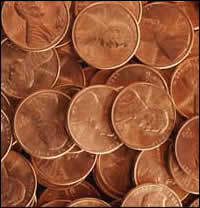Please read all the instructions before you begin and record your results throughout the experiment. Then compare your results with a friend!
Materials
- 10 dirty pennies
- 4 tablespoons lemon juice
- 8 tablespoons vinegar
- 1 teaspoon salt
- small bowl (not metal!)
- 1 spoon (not metal!)
- paper towels or napkins
Instructions
- Mix the lemon juice, vinegar and salt in the bowl until dissolved.
- Take a penny and dip it half way into the mixture for 20 seconds. Take it out - what happened?
- Put the rest of the pennies into the mixture. Watch carefully. What happens?
- In 5 minutes, take 4 of the pennies out and lay them on a paper towel to dry.
- Take the remaining pennies out of the mixture and hold them under running water until they are thoroughly rinsed. Lay them out to dry on another paper towel and label them "clean."
What Happened?
Why did the pennies look dirty when you started the experiment?
 In mid-November 1997, Congress authorized the U.S. Mint to issue the new dollar coin to replace the Susan B. Anthony dollar. The new gold colored coin is made up of 90% copper.
In mid-November 1997, Congress authorized the U.S. Mint to issue the new dollar coin to replace the Susan B. Anthony dollar. The new gold colored coin is made up of 90% copper.The penny contains only 2.6% copper. In 1982, the U.S. Mint converted production of the 95% copper coin to a predominantly zinc alloy, but coated it with copper to preserve its appearance.
The U.S. nickel is actually 75% copper. The dime, quarter, and half dollar contain 91.7% copper.
Chemistry can answer these questions! Do you know what an atom is? Atoms are microscopically tiny particles that are the basic building blocks of virtually everything we can see. Our bodies are made up of billions and billions of atoms - all different shapes and sizes. But some things are made up of only one kind of atom. For example, the copper used for pennies is made up mainly of copper atoms. But when they join with other atoms, like oxygen in the air, they form molecules - in this case a molecule called copper oxide. The copper oxide makes the pennies look dirty.
Why does the mixture clean the pennies?
The mixture is acidic, and the acid from the lemon juice and vinegar dissolves the copper oxide. Why not try to dissolve copper oxide in other acidic mixtures! What can you think of?
The pennies that weren't rinsed turned a blue color. Why?
When the mixture removes the copper oxide, it becomes easy for the copper atoms to join together with oxygen and chlorine (salt). When this happens, a new compound is formed, called malachite. Malachite is usually blue-green.
